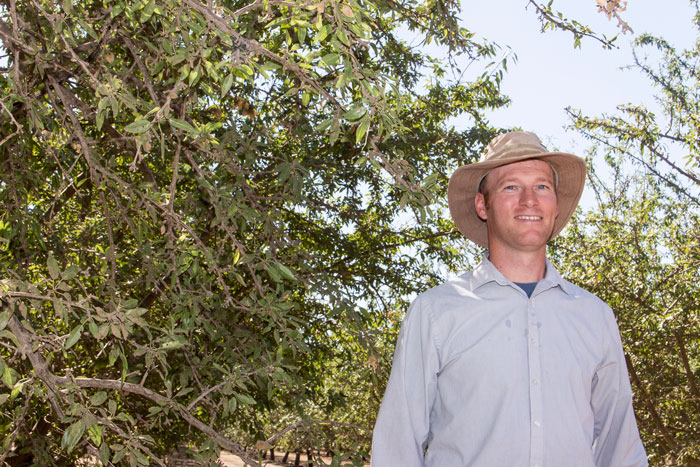
Salted almonds may taste good, but put too much salt in the soil or water used to grow them and almond trees don’t do well.
While almond farmers in California are short on water they must contend with too much salt in the soil, which is being exacerbated by poor-quality well water to compound the problem.
University of California Farm Advisor David Doll says salt damage will soon become more evident in places like the western edge of the San Joaquin Valley, where saline soils and brackish water are more common.
“I expect to see burnt leaves and other signs of salt damage fairly soon,” Doll said.
Managing for the salty conditions will be a delicate balancing act for growers this season, Doll says. The key will be if enough rain falls this winter to help leach these accumulated salts from the soil and help trees recover.
That’s why Doll has recommended in the past that growers not be so quick to turn off drip irrigation when it rains at certain times of the year. The added water can help push salt past the root zones more effectively.
Just how much salt these trees can handle is already known, Doll says.
“After we hit about 1.5 deci Siemens per meter (dS/m) we see reduction in growth and yield,” Doll told an audience of growers and crop advisors at the South San Joaquin Valley Almond Symposium in Kerman, Calif.
For every dS/m above 1.5, growth rate decreases from 18-21 percent.
Salt is already present in the soil to some degree, Doll says. Some areas of the state are worse than others. Doll’s region of Merced County, which includes areas surrounding Livingston, Atwater and Hilmar, can be particularly bad for soil salinity in the region’s coarse soil profiles.
These areas, particularly when irrigated with well water, can quickly accumulate high levels of sodium. Other areas of the San Joaquin Valley and lower Sacramento Valley can be problematic not only for sodium, but chloride and boron.
“Don’t forget about Boron; it can sneak in on you and cause toxicity as well,” Doll told the group.
Boron toxicity can reveal itself in gumming at tree wounds.
Tree roots attempt to keep salt from being taken up the best they can, Doll says, and most of the salt is excluded. Successive irrigations through the season build the concentration of salt within the root zone and can reduce growth due to the osmotic effects. As salt levels increase, water will move out of the plant roots, unless the plant increases salt concentration within the roots.
As the plant focuses energy on expelling the salts the result is less energy for growth and nut production, reducing growth and vigor. Trees can also appear water stressed, even though soil has adequate moisture.
At some point, the salt levels within the soil increase to a concentration that the root is no longer able to exclude it. Uptake of the toxic salts occurs, which leads to burnt leaves and defoliation. Both the osmotic effects and tissue toxicity lead to decreased yield.
This is why the source of irrigation water is critical for almond farmers. Generally the surface water they receive is higher quality than their well water. As California almond growers are in their second consecutive season of zero surface water allocations, blending the better surface water with poorer-quality well water is not an option.
With the drought and limited water resources there is little in the short-term that growers can do to address soil salt levels. However, Doll advises growers to plan ahead for when rains do return.
According to Doll, leaching during the dormant season needs to be started early in order to complete it before root expansion, which typically takes place in mid-January.
To achieve leaching it is important to begin to fill the soil profile early with consistent irrigations ahead of any winter rains. If possible the profile should be filled to five feet before the beginning of December, which will provide the ability to take advantage of any rain that does fall. Once the soil profile is full, smaller quantities of water through rain or frequent irrigation are the best way to move salts below the root-zone, Doll says.
Doll cautions to be careful to not saturate the soil for prolonged periods as this may increase the risk of root disease.
About the Author(s)
You May Also Like






